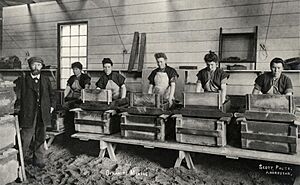Dynamite facts for kids
Dynamite is a powerful explosive material invented by a Swedish scientist named Alfred Nobel. Its main ingredient is nitroglycerin, which is a very strong explosive. However, nitroglycerin is also very dangerous because it can explode easily if it's moved or bumped.
To make nitroglycerin safer to use, Alfred Nobel mixed it with a special kind of soft rock called diatomaceous earth. This rock is made from tiny fossilized plants called diatoms. When nitroglycerin is absorbed into diatomaceous earth, it becomes much more stable and less likely to explode by accident.
Even with diatomaceous earth, dynamite could still be tricky to use, especially in wet places. Water could make the nitroglycerin leak out, which was still dangerous. So, later on, a different material called gelignite was used instead of diatomaceous earth. Gelignite holds the nitroglycerin even better, preventing it from leaking in water.
Today, dynamite isn't used as much as it used to be. Newer explosives, often made with ammonium nitrate and gelignite, have taken its place. These new explosives are usually cheaper to make and even safer to handle than dynamite. But you might still see dynamite shown in movies or books!
How Dynamite Was Invented
Dynamite was invented by the Swedish chemist Alfred Nobel in 1866. Before dynamite, the most common explosive was black powder. Dynamite was the first explosive that was stronger than black powder and also safe enough to manage.
Alfred Nobel's father, Immanuel Nobel, was an engineer and inventor. He built bridges and buildings. His work made him think about better ways to blast rock than using black powder. Alfred Nobel traveled a lot and studied chemistry. In France, he met a chemist named Ascanio Sobrero, who had first made nitroglycerin in 1847. Sobrero warned Nobel that nitroglycerin was too dangerous to use because it was so sensitive to shocks.
But Alfred Nobel was very interested in nitroglycerin's power. He wanted to find a way to use it safely. In 1863, he invented the detonator, also called a blasting cap. This was a small device that could set off a controlled explosion of nitroglycerin from a distance using a fuse. This was a huge step forward!
Sadly, in 1864, Alfred's brother Emil and several others were killed in an explosion while experimenting with nitroglycerin. This accident made Alfred even more determined to make explosives safer. He moved his work to a more isolated area and started a company called Nitroglycerin Aktiebolaget.
Even with the blasting cap, nitroglycerin was still too unstable to be used widely. Nobel kept trying to mix it with other substances to make it safe to transport and handle, without making it less powerful. He tried many things like cement and sawdust, but they didn't work. Finally, he tried diatomaceous earth, which is a type of fossilized algae. He found this material near his factory in Germany. When he mixed nitroglycerin with diatomaceous earth, it worked! The nitroglycerin became stable and safe to move around.
Nobel received patents for his invention in England in May 1867 and in Sweden in October 1867. Once dynamite was introduced, it quickly became very popular. It was a much safer choice than black powder or pure nitroglycerin. Nobel made sure his invention was protected by patents, so others couldn't copy it without permission.
Alfred Nobel first called his invention "Nobel's Blasting Powder." Later, he changed the name to dynamite. The word "dynamite" comes from the Ancient Greek word dýnamis, which means "power."
Images for kids
-
Preparation of dynamite during the construction of the Douglas Dam, 1942.
See also
 In Spanish: Dinamita para niños
In Spanish: Dinamita para niños





